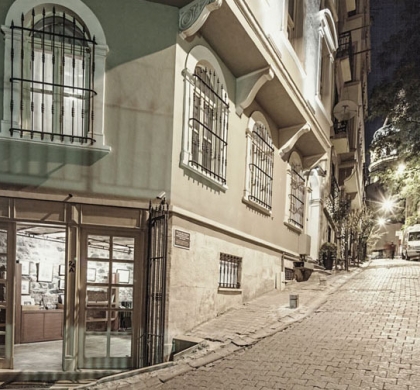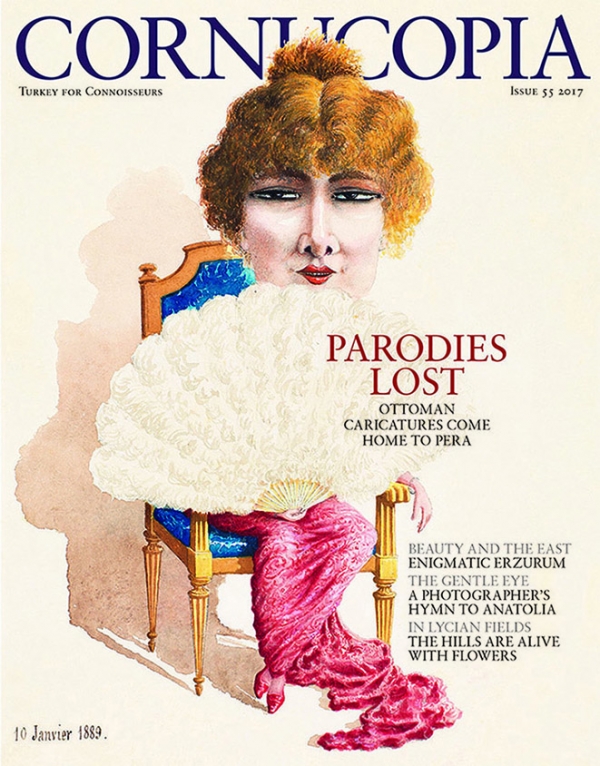Buy or gift a stand-alone digital subscription and get unlimited access to dozens of back issues for just £18.99 / $18.99 a year.
Please register at www.exacteditions.com/digital/cornucopia with your subscriber account number or contact subscriptions@cornucopia.net
Buy a digital subscription Go to the Digital EditionTwo shows in Istanbul featuring the English-born Navine G Khan-Dossos, a visual artist steeped in the Islamic tradition, afford a rare chance to see an expanded vision of her measured philosophy. As Jamie Leptien discovers, the surface beauty hides intellectual steel. Photographs by Monica Fritz
I was standing talking with the artist Navine G Khan-Dossos when I noticed a pink building across a courtyard. “Puce”, she said. “Or Mountbatten pink. Mountbatten pink was developed by Lord Mountbatten because he thought it would make ships harder to see at dawn and dusk. But they ended up getting shot at anyway, because… well, they were pink.”
Anyone who has seen Khan-Dossos’s 2016 work Imagine a Palm Tree at the Benaki Museum of Islamic Art (see Cornucopia 55) in her adopted home of Athens will not be surprised by her preoccupation with colour. Now the London-born Khan-Dossos is back exhibiting in Istanbul for the first time since 2010, with works at two venues on İstiklâl Caddesi, the European side’s bustling pedestrian thoroughfare. While very different in many ways, each exemplifies the marriage of colour and pattern with intellectual precision and depth that has become her trademark.
Khan-Dossos as an artist is inspired by the Islamic tradition, though her choice of subject matter remains unrestricted by any single culture. She has a preference for aniconism, non-figurative representation of the natural world and sentient beings, and a fascination with Orientalism in a digital age. Early paintings such as The First Televised Bullfight (2008) cleverly reversed “West = new; East = old” stereotypes by applying geometric Islamic patterns as a form of pixelation. Her studies included a BA in Ottoman art and architecture at Cambridge and an MA in fine art at the Chelsea College of Art and Design. During her time at Cambridge, a visit to Turkey proved to be a turning point. “I had an epiphany in the Green Mosque [the Yeşil Cami] in Bursa,” she says. “Whatever it was that was generated by that space was something that I wanted to be able to generate as an artist. It has a very precise philosophical and conceptual context, in which things are being said through the colours, through the patterns. “A mural, likewise, can surround you from all sides – it is an environment, not just a painting. Being enveloped in a floor-to-ceiling work creates a contemplative space where the viewer can experience and meditate on the subject at hand from within the work.”
In recent years, Khan-Dossos has increasingly tended towards site-specific work. Imagine a Palm Tree was inspired by the conflicted symbolic history of the palm tree in Athens, filling the top-floor café at the city’s Benaki Museum of Islamic Art with a floor-to-ceiling mural of riotous colour and symbolic patterns, referencing everything from Wi-Fi to Western decorative art and Islamic architecture. Scenes from a Pre-Crime (Performance for Security Guards), currently installed at Salt Beyoğlu as part of a group exhibition, The Universe Flickers, continues her preference for a sense of place. The work comprises a series of monochrome murals painted in gouache wash on 200 square metres of exhibition space over three floors.
When first encountered on the ground floor, these murals appear purely decorative: pleasing symmetrical columns of gentle interior tones bordered by black-and-white patterned strips. It is not until we follow the columns to the third floor that we see their points of origin, in a series of carefully restored and intriguingly detailed ceiling paintings from the building’s 19th-century incarnation as the Siniossoglou Apartmanı. By encountering the origin of the work last, the viewer experiences it in reverse, and is sent on an imaginative daydream into the past life of the building, when the ground floor was a commercial space and the upper floors were apartments.
But what to make of the work’s title? As those who have read Philip K Dick’s story ‘The Minority Report’, or seen Steven Spielberg’s film adaptation, may remember, a pre-crime is a crime foreseen (by a set of futuristic oracles) with enough certainty to convict the would-be perpetrator. This resonates with the black-and-white strips bordering the murals, which represent forensic rulers, traditionally used by police photographers to calibrate the colours in crime-scene photographs. Perhaps aware that a number of national police forces are looking to make this dystopic future a reality, with real-time surveillance data and predictive algorithms in the role of the oracles, Khan-Dossos’s work can be seen to give a quietly pointed reminder: metaphysically speaking, the scene of a pre-crime is a blank space. Performance for Security Guards, meanwhile, is explained by the fact that Khan-Dossos spent a month hand-painting the murals, with only the building’s security guards for company. Touched by their repeated acts of kindness, she dedicated the work to them.
If there seems something inherently photogenic in her work, that is probably because the artist restricts herself to the seven colours of reproduced imagery: cyan-yellow-magenta-key (CYMK, used in print) and red-green-blue (RGB, used in televised and computerised imagery). Bottles of paint in all these colours are laid out at The School of Earthquake Diplomacy, Khan-Dossos’s other work currently on display in Istanbul, at Arter. The term “earthquake diplomacy” was coined to describe the improved diplomatic relations that resulted from earthquakes that struck Greece and Turkey in 1999. When an earthquake hit İzmit, close to Istanbul, on August 17, Greece was the first country to send emergency aid, and Turkey returned the favour when Athens itself was struck by an earthquake on September 7.
In contrast to Scenes from a Pre-Crime, the works here are dense with colour and visual information, using symbols drawn from the international language of earthquake iconography. Layers of patterned colour reverberate out from the centre of the circles, echoing the physical process of an earthquake.
To reflect a spirit of mutual support and cooperation, Khan-Dossos created each work by alternating layered paintings produced by participants in workshops in Greece and Turkey. Perhaps fittingly, only a seismographer would be able to tell immediately which painting represents which earthquake: at the centre of each is a black-and-white focal mechanism, a “beach ball diagram” that corresponds to a type of quake – a “strike-slip” in the case of İzmit, and a “normal slip” at Athens. Though they originate in a historical moment, the paintings’ eye-catching colours seem designed as a warning, possibly of the earthquake to come.
● ‘The Universe Flickers’, at SALT Beyoğlu, İstiklâl Cad 136, Beyoğlu, Istanbul, until December 30; saltonline.org
● ‘The School of Earthquake Diplomacy’, at Arter, İstiklâl Cad 211, Beyoğlu, Istanbul, until November 4, is part of ‘Earth School’ at the 4th Istanbul Design Biennial; arter.org.tr
● For more on the artist, see khandossos.com
Norman Stone chronicles the colourful but shadowy life of a polyglot Orientalist
The late Brian McKee’s photographic essay on the İshak Pasha Palace on Turkey’s eastern border · 68
Assyrian treasures at the British Museum
Everyday life on the edge of the Assyrian Empire
Dazzling Byzantine mosaics in Palermo, by Robert Ousterhout
Berrin Torolsan on the potency of chard and beetroot




Cornucopia works in partnership with the digital publishing platform Exact Editions to offer individual and institutional subscribers unlimited access to a searchable archive of fascinating back issues and every newly published issue. The digital edition of Cornucopia is available cross-platform on web, iOS and Android and offers a comprehensive search function, allowing the title’s cultural content to be delved into at the touch of a button.
Digital Subscription: £18.99 / $18.99 (1 year)
Subscribe now